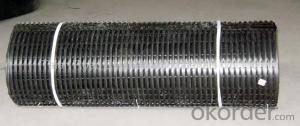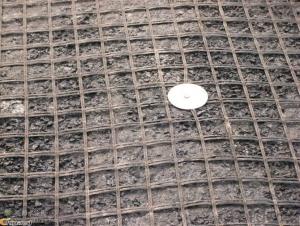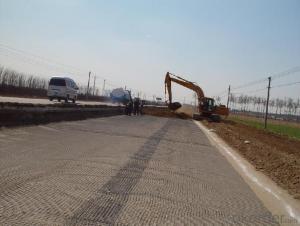Fiberglass geogrid for Airport road protection- Hot sell
- Loading Port:
- Qingdao
- Payment Terms:
- TT OR LC
- Min Order Qty:
- 1000 m²
- Supply Capability:
- 1000000 m²/month
OKorder Service Pledge
OKorder Financial Service
You Might Also Like
1.Brief Introduction
good thermal stability : the melting point of glass fibers is above 1000 °C , to ensure the stability of the glass fiber geogrids to withstand high temperature in a paving job .
Product has high strength, low elongation, high temperature, high modulus , light weight , good toughness, corrosion resistance , long life , etc. , can be widely used in the old concrete pavement , maintenance of airport runways , dams , river banks , while slope protection , road bridge , enhancement engineering field, to the road surface can be enhanced , reinforced to prevent pavement rutting fatigue crack , hot and cold telescopic cracks and reflection cracks below , and can the pavement load stress dispersion , extending pavement life .
2.Characteristics
The high tensile strength low - elongation : Fiberglass geogrid is a glass fiber , while the high tensile strength of glass fiber , more than other fibers and ordinary metals . Its high modulus , high resistance to deformation , elongation at break of less than 3% .
3.Application
Physical and chemical stability after special treatment agent coated handle , fiberglass geogrid to resist a variety of physical wear and chemical attack , but also to resist biological erosion and climate change to ensure that its performance is unaffected by the loss .
4.FAQ
3 No long-term creep : as a reinforcing material , with the ability to resist deformation under the load in the long-term creep resistance is extremely important, the glass fiber will not creep , to ensure that the products can long-term performance .

- Q:Is fiberglass fabric resistant to staining?
- Yes, fiberglass fabric is generally resistant to staining. The material is made from fine fibers of glass, which are woven together to create a strong and durable fabric. Fiberglass fabric is known for its non-porous nature, which means that it does not easily absorb liquids or substances that could cause staining. This makes it highly resistant to most stains, including those caused by common household items such as food, beverages, oil, and grease. Additionally, fiberglass fabric is often treated with a protective coating or finish, further enhancing its stain-resistant properties. However, it is important to note that while fiberglass fabric is resistant to staining, it is not completely immune to all types of stains. Some particularly stubborn or harsh substances, such as certain chemicals or dyes, may be able to cause discoloration or staining on fiberglass fabric. Therefore, it is always advisable to promptly clean any spills or stains on fiberglass fabric to ensure its long-term durability and appearance.
- Q:What are the different fiberglass fabric finishes for UV resistance?
- There are several different fiberglass fabric finishes available for UV resistance. These finishes are applied to the surface of the fabric to protect it from the damaging effects of ultraviolet (UV) radiation. Some common fiberglass fabric finishes for UV resistance include: 1. Silicone Coating: This finish provides excellent UV resistance and is often used in applications where high flexibility and heat resistance are required. Silicone-coated fiberglass fabrics are commonly used in industries such as aerospace, automotive, and construction. 2. Acrylic Coating: Acrylic-coated fiberglass fabrics offer good UV resistance and are known for their durability and resistance to abrasion. These finishes are often used in outdoor applications, such as awnings, canopies, and outdoor furniture. 3. PTFE Coating: Polytetrafluoroethylene (PTFE) coatings provide exceptional UV resistance and are known for their non-stick properties. PTFE-coated fiberglass fabrics are commonly used in applications where low friction, high heat resistance, and UV protection are required, such as conveyor belts, release sheets, and insulation covers. 4. PVC Coating: Polyvinyl chloride (PVC) coatings offer good UV resistance and are commonly used in applications where waterproofing and UV protection are required. PVC-coated fiberglass fabrics are often used in outdoor covers, tents, and tarps. 5. Polyurethane Coating: Polyurethane (PU) coatings provide good UV resistance and are known for their flexibility and resistance to chemicals. PU-coated fiberglass fabrics are often used in applications where flexibility, UV protection, and resistance to oils and solvents are required, such as flexible ducting, protective clothing, and inflatable structures. It is important to note that the choice of fiberglass fabric finish for UV resistance depends on the specific requirements of the application. It is recommended to consult with a knowledgeable supplier or manufacturer to determine the most suitable finish for a particular application.
- Q:Are there any specific safety precautions to consider when working with fiberglass fabrics?
- Yes, there are specific safety precautions to consider when working with fiberglass fabrics. Fiberglass can release tiny, sharp fibers that can irritate the skin, eyes, and respiratory system if inhaled. Therefore, it is important to wear protective clothing, gloves, goggles, and a mask to minimize exposure. Additionally, working in a well-ventilated area or using proper respiratory protection is recommended to prevent the inhalation of any airborne fibers.
- Q:Is fiberglass fabric resistant to chemicals used in food processing?
- Yes, fiberglass fabric is generally resistant to chemicals used in food processing. Fiberglass fabric is known for its high chemical resistance, making it suitable for various industrial applications, including the food processing industry. It can withstand exposure to a wide range of chemicals, including acids, alkalis, solvents, and oils, commonly used in food processing. Additionally, fiberglass fabric is non-reactive and non-toxic, ensuring that it does not contaminate food products. However, it is important to note that the specific chemical resistance of fiberglass fabric may vary depending on the specific type and quality of the fabric. Therefore, it is recommended to consult with the manufacturer or supplier to ensure that the fiberglass fabric being used is appropriate for the specific chemicals used in food processing.
- Q:Can fiberglass fabric be used for reinforcement in pipes and tanks?
- Indeed, pipes and tanks can benefit from the reinforcement offered by fiberglass fabric. This material boasts exceptional strength and durability, along with its ability to resist corrosion, rendering it an optimal selection for reinforcing structures that might endure severe chemicals or extreme temperatures. The fabric can be affixed to either the inner or outer surface of the pipe or tank, delivering enhanced stability and strength. Furthermore, fiberglass fabric offers the advantage of being lightweight and flexible, enabling it to conform effortlessly to the shape of the pipes or tanks, guaranteeing a reliable and efficient reinforcement.
- Q:Can fiberglass fabric be used for reinforcement in wastewater treatment tanks?
- Indeed, fiberglass fabric proves to be a suitable choice when it comes to reinforcing wastewater treatment tanks. Renowned for its exceptional strength-to-weight ratio, resistance to corrosion, and long-lasting nature, fiberglass fabric emerges as the perfect material to fortify structures that encounter harsh conditions similar to those found in wastewater treatment tanks. By seamlessly applying the fabric onto the tank's surface, an extra layer of robustness and structural integrity is achieved. Moreover, fiberglass fabric's resistance to chemical attacks becomes paramount in wastewater treatment tanks, where corrosive substances frequently exist. Ultimately, the utilization of fiberglass fabric in reinforcing wastewater treatment tanks significantly enhances their durability and performance.
- Q:Can fiberglass fabric be used for making electronic devices?
- Yes, fiberglass fabric can be used for making electronic devices. Fiberglass fabric is a widely used material in the electronics industry due to its excellent thermal and electrical insulation properties. It is commonly used as a substrate material for printed circuit boards (PCBs) and as an insulating layer for various electronic components. The fabric's high strength and dimensional stability make it suitable for creating rigid PCBs that can withstand the heat generated by electronic components. Additionally, fiberglass fabric can also be used for creating flexible PCBs, which are commonly found in wearable devices and other portable electronics. Overall, fiberglass fabric is a versatile material that is commonly used in the manufacturing of electronic devices.
- Q:What is the heat resistance of fiberglass fabric?
- Fiberglass fabric boasts a remarkable resistance to heat, enabling it to endure temperatures as high as 1000 degrees Fahrenheit (537 degrees Celsius) without experiencing notable harm or deterioration. This outstanding characteristic renders it an exceptional selection for various purposes that entail exposure to extreme heat, including welding blankets, insulation materials, and fire-resistant clothing. Moreover, fiberglass fabric exhibits a low thermal conductivity, signifying its limited ability to conduct heat effectively, thereby offering an extra shield of defense in environments with elevated temperatures.
- Q:What does "PCB" mean?
- We can't transmit electrical signals just as insulation plates, so we need to cover the surface with copper. So we call the PCB board a copper clad substrate. In the factory, the common copper substrate in this code is FR-4, each card manufacturers which in general there is no difference, so we can think of everyone at the same starting line, of course, if it is best to use high frequency board, copper clad PTFE glass cloth laminate high cost. The process of copper is very simple, generally can be made by rolling and electrolytic solution, the so-called rolling is Gao Chundu (>99.98%) of the copper rolling method on the PCB substrate, because the adhesive has excellent epoxy resin and copper foil, copper foil adhesive strength and high working temperature, can be no bubble dip in the molten tin is 260 DEG C in. This process is like rolling dumpling wrappers, but the dumpling wrappers are thin and thin. The thinnest is less than 1mil (industrial unit: mil, 1/1000 inches, equivalent to 0.0254mm)! If the dumpling wrappers are so thin, the pot must leak! The so-called electrolytic copper in junior high school chemistry has learned, CuSo4 electrolyte can continuously manufacture a layer of "copper foil", this is more easy to control the thickness, the longer the copper foil the more thick! Usually the factory has strict requirements on the thickness of copper foil, usually between 0.3mil and 3mil, and has a dedicated copper foil thickness tester to test its quality. Like old radios and amateur PCB, copper is especially heavy, and the quality of the factory is far worse than the computer board.
- Q:Is fiberglass fabric resistant to fire in public buildings?
- Yes, fiberglass fabric is highly resistant to fire, making it a suitable choice for public buildings where fire safety is a concern.
1. Manufacturer Overview |
|
|---|---|
| Location | |
| Year Established | |
| Annual Output Value | |
| Main Markets | |
| Company Certifications | |
2. Manufacturer Certificates |
|
|---|---|
| a) Certification Name | |
| Range | |
| Reference | |
| Validity Period | |
3. Manufacturer Capability |
|
|---|---|
| a)Trade Capacity | |
| Nearest Port | |
| Export Percentage | |
| No.of Employees in Trade Department | |
| Language Spoken: | |
| b)Factory Information | |
| Factory Size: | |
| No. of Production Lines | |
| Contract Manufacturing | |
| Product Price Range | |
Send your message to us
Fiberglass geogrid for Airport road protection- Hot sell
- Loading Port:
- Qingdao
- Payment Terms:
- TT OR LC
- Min Order Qty:
- 1000 m²
- Supply Capability:
- 1000000 m²/month
OKorder Service Pledge
OKorder Financial Service
Similar products
New products
Hot products
Related keywords




























